Articles Menu
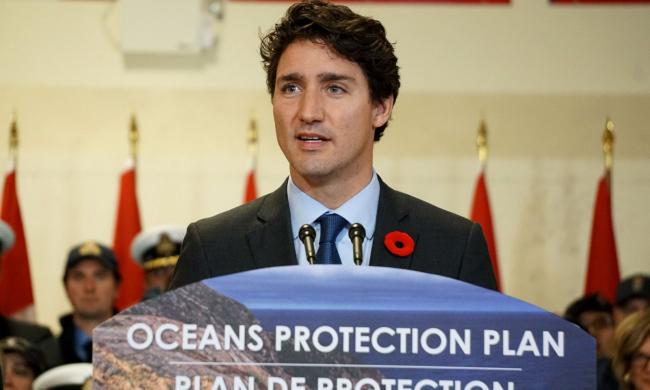
As cabinet ministers weigh the pros and cons of a major oilsands expansion project that would send tanker traffic soaring in southern B.C. waters, the federal government has announced an unprecedented $1.5-billion investment in marine safety along Canadian coastlines.
Its implementation, starting in 2017, would impact the way first responders handle oil spills on the water, and comes only weeks before the federal government is due to decide the fate of Kinder Morgan's Trans Mountain expansion, a pipeline proposal that includes oil tanker shipments from Burnaby, B.C. to overseas markets.
"This robust national plan will protect our coastlines from the damage that comes from shipping and pollution," said Trudeau. "These measures are progressive and proactive, and will ensure the health of our oceans for generations to come."
The announcement is particularly timely as a 37-metre gravel and sand barge bound for Alaska flipped and sunk in central B.C. waters on Sunday. The accident took place roughly 55 kilometres north of the site where a tanker and barge unit ran aground mid-October in the traditional territory of the Heiltsuk First Nation, spilling more than 200,000 litres of fuel into waters where the community harvests most of its food.
Trudeau said the spill in Heiltsuk territory is "unacceptable," and that the National Oceans Protection Plan was "long overdue." The legislation represents the most significant investment ever made in protecting Canada's oceans, he added.
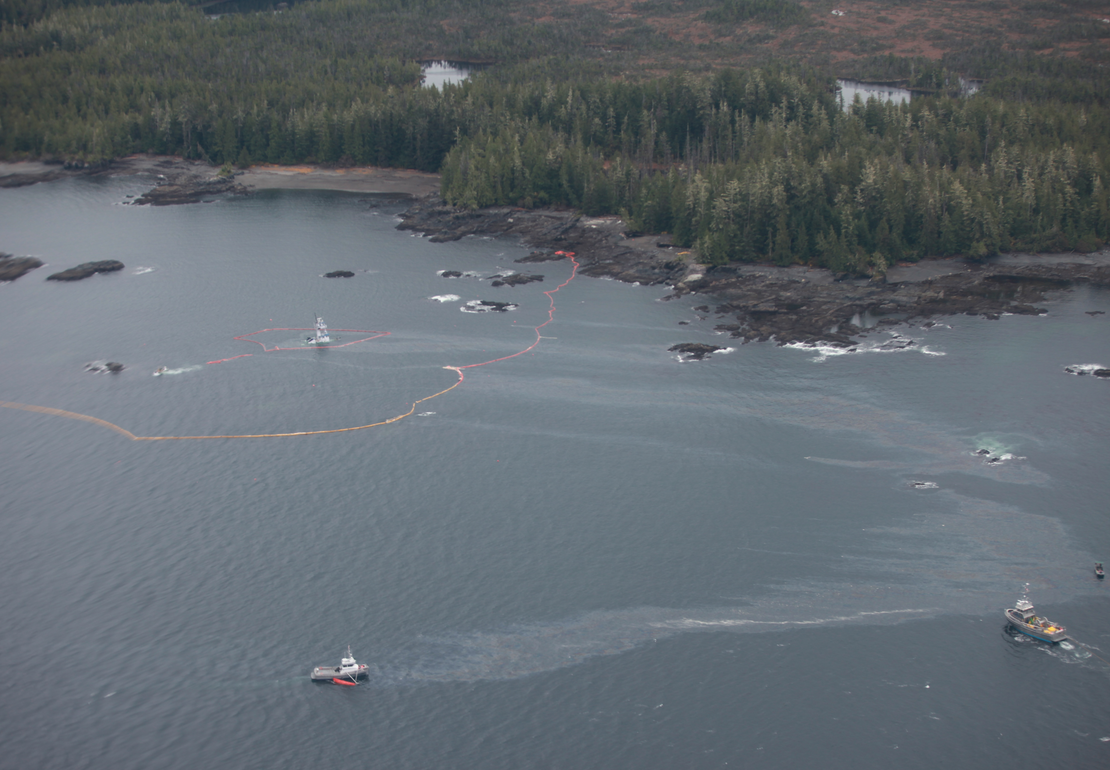 A diesel spill in the Heiltsuk First Nation's traditional territory escapes containment efforts of first responders in October 2016. Photo courtesy of the Heiltsuk First Nation.
A diesel spill in the Heiltsuk First Nation's traditional territory escapes containment efforts of first responders in October 2016. Photo courtesy of the Heiltsuk First Nation.
First Nations, environmentalists, and the B.C. government have been calling for stronger federal protection for Canadian coasts for years, including the establishment of a coast guard base in Prince Rupert, B.C., new salvage vessels, and monitoring systems to monitor vessel traffic. At the BC Liberal Convention in Vancouver on Sunday, Premier Christy Clark said the province's coastline is "under threat," and asked Trudeau to reverse a trend of chronic under-funding for marine protection:
"We have been cheated by a federal government for a long time while resources have gone to the east," she told delegates. "(Trudeau) has a chance to change it."
While the prime minister did not specifically address Clark's demands on Monday, he said the new Oceans Protection Plan was modelled after "world class" leaders in marine safety in Norway, Alaska, and other jurisdictions, and developed over two years of collaborative work with Indigenous people, coastal communities, and various government programs. It will be formally launched in 2017, and include improved marine traffic and navigation methods, legislation to prohibit vessel abandonment in Canadian waterways, greater resources for the Canadian Coast Guard, and a Maritime Rescue Sub-Centre in St. John's.
"Canada's economy, environment and history are inextricably linked to our coastal regions," he explained. "We know that to build a strong economy we need to protect the environment at the same time."
Additional investments, to be delivered over a five-year period, include new rescue stations, new towing capacity, new communications equipment, new research on the impacts of increased shipping on marine ecosystems, and new oil spill response methods. But a group of Indigenous activists, conservationists, and pipeline protesters outside the announcement say these measures still fall short of what's required to truly protect Canadian waters.
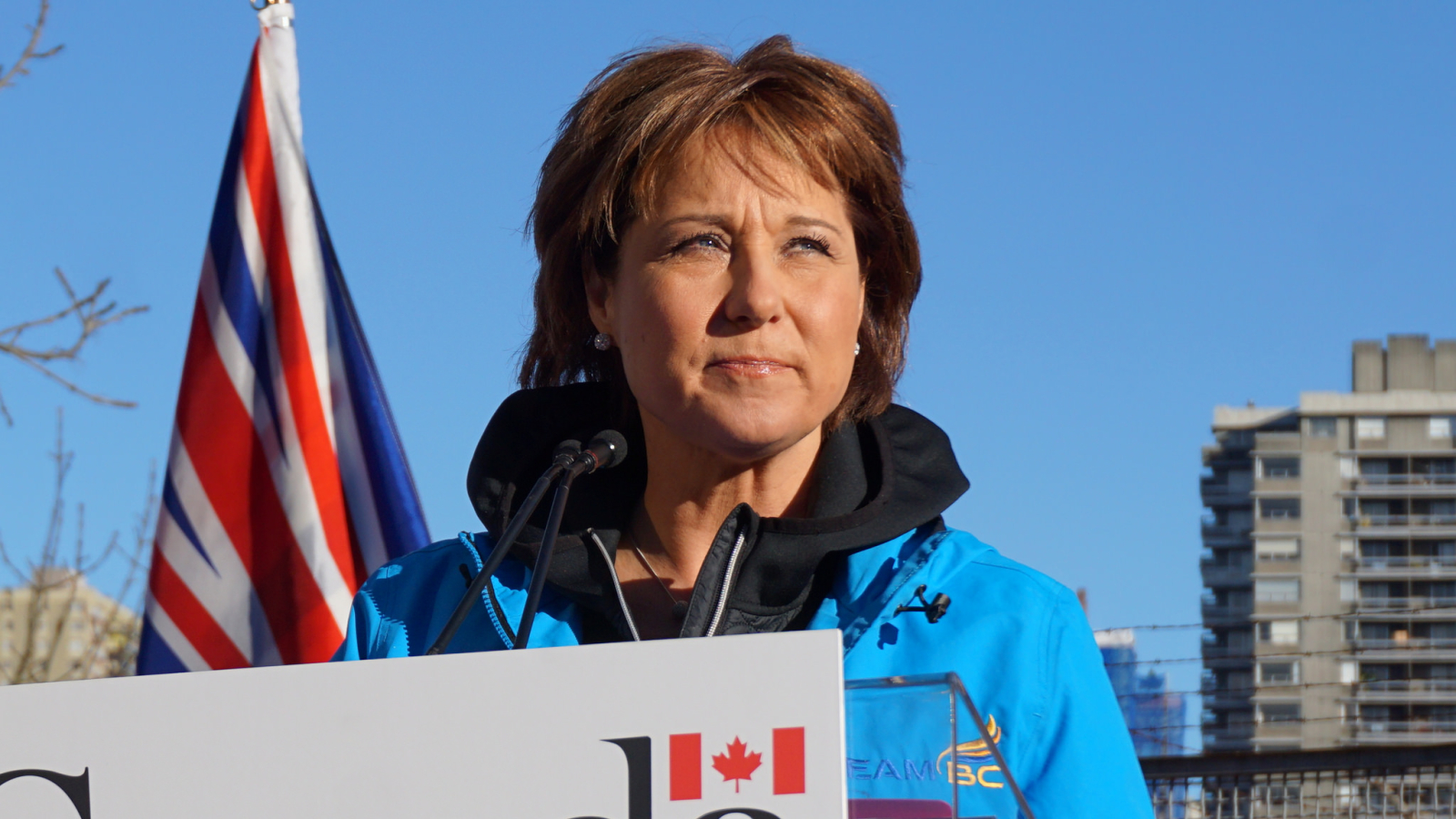 Premier Christy Clark celebrates the re-opening of the Kitsilano Coast Guard Station with then-minister of Fisheries and Oceans, Hunter Tootoo on Dec. 16, 2015 in Vancouver, B.C. Photo by Elizabeth McSheffrey.
Premier Christy Clark celebrates the re-opening of the Kitsilano Coast Guard Station with then-minister of Fisheries and Oceans, Hunter Tootoo on Dec. 16, 2015 in Vancouver, B.C. Photo by Elizabeth McSheffrey.
"It's a step in the right direction," said Heiltsuk Chief Marilyn Slett, whose community in Bella Bella, B.C. is still working to contain the October diesel spill that shut down vital clam and shellfish harvesting sites and contaminated local wildlife. "But the proof will be in the delivery for us."
In his speech, Trudeau acknowledged that First Nations are "always the first responders" to oil spills and promised that the new marine safety plan will be co-managed by Indigenous communities, and include new training and equipment for their own emergency response teams. He did not however, offer a start date for the crude oil tanker ban he promised for B.C.'s northern coast, which Chief Slett has described as "critical" for protecting the B.C. coast.
"We are coastal people and have to be a part of these authorities and responsibilities going forward, and also have a say about the shipping and whose traversing through our traditional territories," she told National Observer. "We can't afford to keep having these disasters."
As it stands, two major pipeline proposals could send tanker traffic soaring along the B.C. coast: the Enbridge Northern Gateway pipeline and Kinder Morgan's Trans Mountain expansion. While the former has been indefinitely delayed as a result of lawsuits, the latter is currently under federal consideration with a cabinet decision due by Dec. 19.
According to the environmental advocacy group, Stand, the track record of the pipeline's Texas-based proponent also doesn't inspire much confidence. Since Kinder Morgan's incorporation in 1997, it has experienced at least 1,800 oil and chemical spill violations and paid more than $2 million in international fines. Just last week, its Canadian president also publicly stated that he wasn't "smart enough" to reach his own conclusions on climate science.
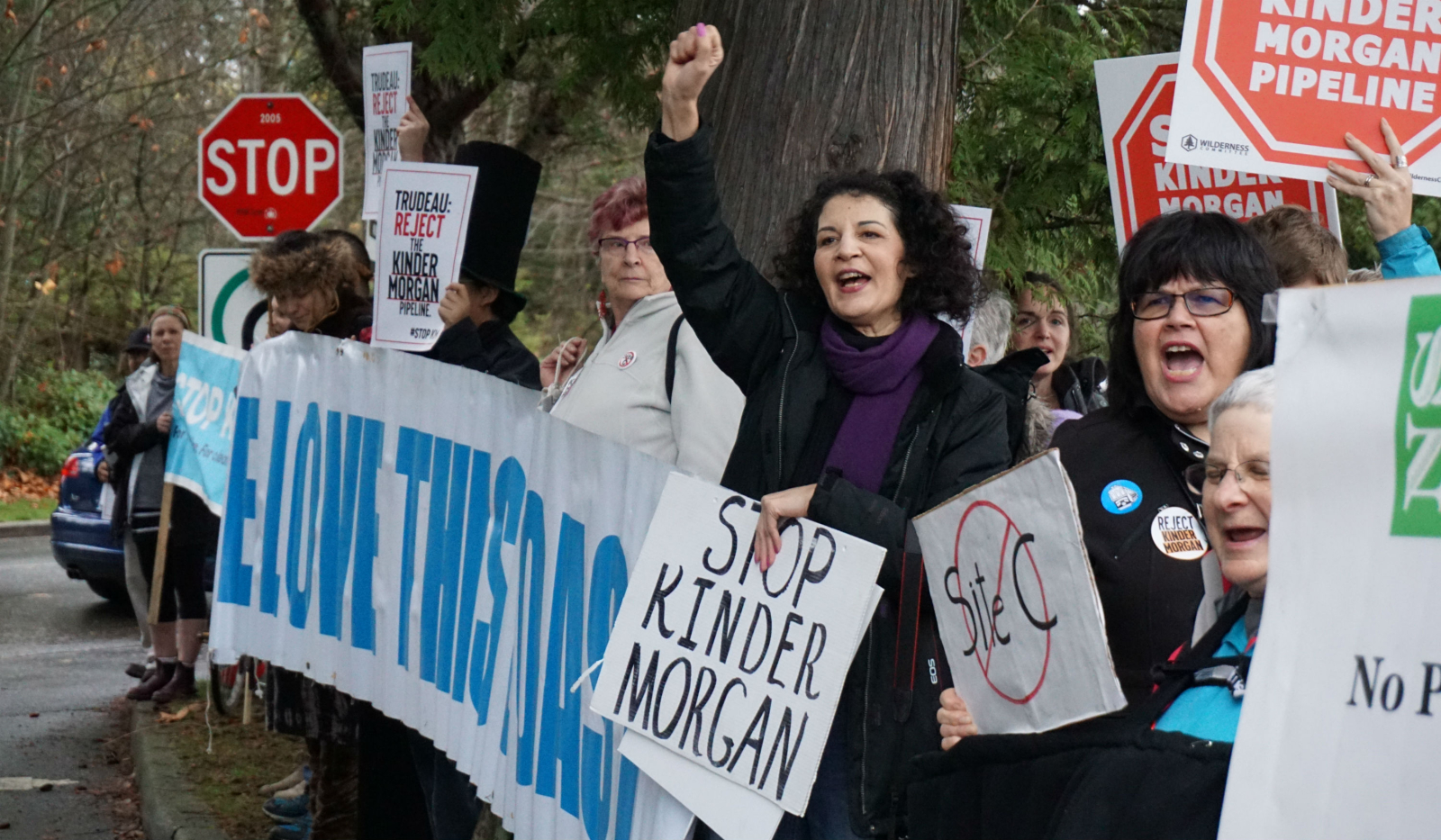 Pipeline protesters demand rejection of the Kinder Morgan Trans Mountain expansion during Prime Minister Trudeau's National Oceans Protection Plan announcement in Vancouver, B.C. on Mon. Nov. 7, 2016. Photo by Elizabeth McSheffrey.
Pipeline protesters demand rejection of the Kinder Morgan Trans Mountain expansion during Prime Minister Trudeau's National Oceans Protection Plan announcement in Vancouver, B.C. on Mon. Nov. 7, 2016. Photo by Elizabeth McSheffrey.
"It's great that they're talking about spill preparedness, but the fact is, bitumen cannot be cleaned up," said Karen Mahon, Canadian director for Stand. "It sinks and there is no amount of money that is going to invent the science that is going to allow us to clean up bitumen."
Even if there is no spill, she added, the endangered Southern resident killer whale could go extinct if the pipeline is built as a result of disturbance or collision with its oil tankers. In its review of the expansion, the National Energy Board (NEB) did not consider the pipeline's impact on oceans, she argued, and the onus now falls on the federal government to conduct that analysis before it decides to approve the project.
"It's not possible for them to approve the Kinder Morgan pipeline until they have a real plan to protect critical (orca) habitat," she said, standing next to a fellow protester dressed in a furry killer whale costume. "These orcas can't live anywhere else, and according to SARA (Species At Risk Act), they need a plan to recover the habitat in this area."
When asked during the announcement however, whether his government would conduct studies under SARA to protect Southern resident orcas before it issues its decision in December, Trudeau did not provide a direct answer:
"We take the responsibilities under SARA extremely seriously in this government and that's why we're engaged very closely in monitoring marine mammals, proper research and habitat protection," he told National Observer. "We know there is an awful lot to do. The Southern pod is particularly vulnerable and that's why we're working with world class scientists, ensuring that we can do what we can to protect these vulnerable populations."
Trans Mountain declined to comment on this story.
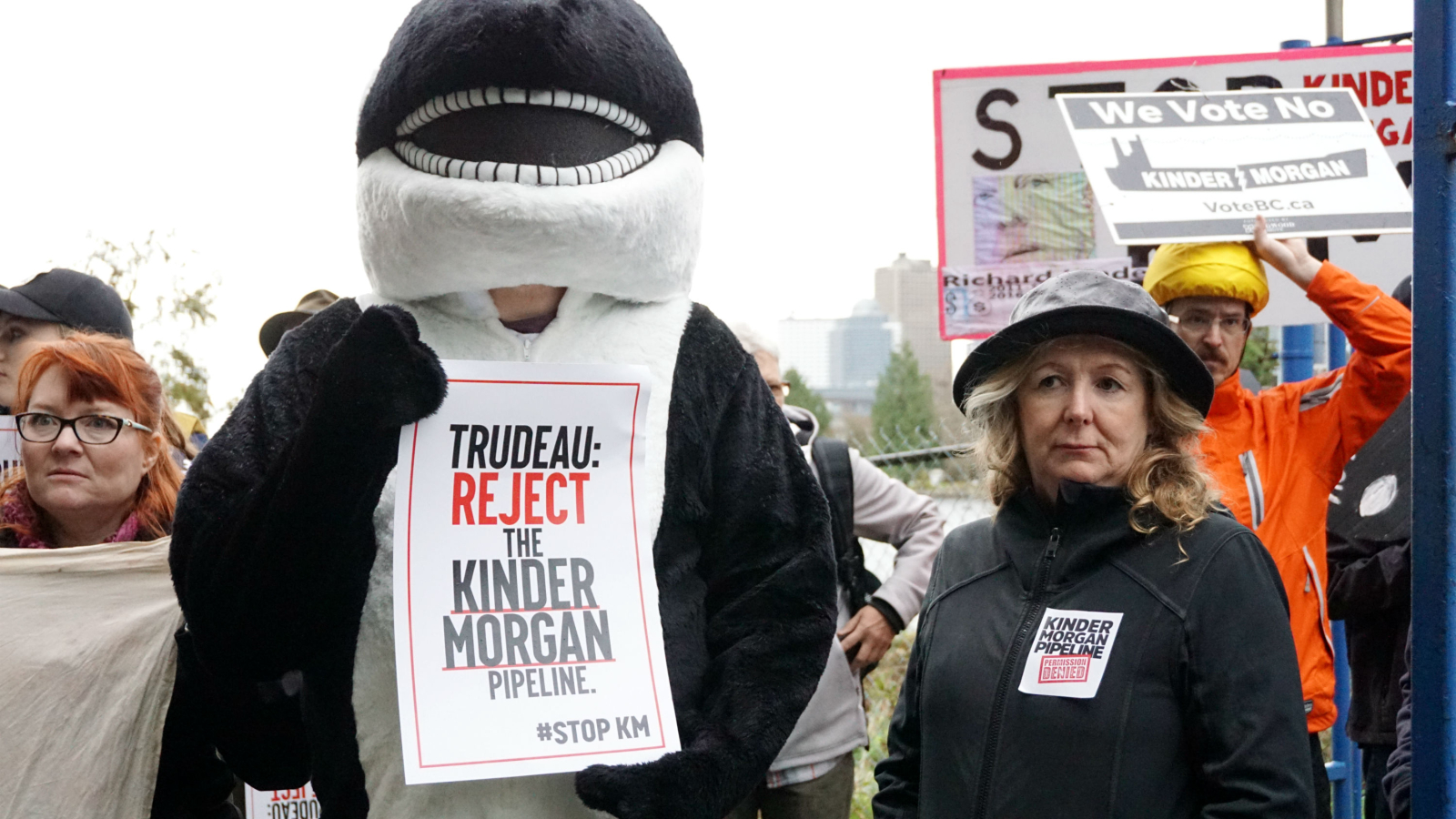 Karen Mahon, Canadian director for Stand.earth protesters the Kinder Morgan Trans Mountain expansion in Vancouver, B.C. on Mon. Nov. 7, 2016. Photo by Elizabeth McSheffrey.
Karen Mahon, Canadian director for Stand.earth protesters the Kinder Morgan Trans Mountain expansion in Vancouver, B.C. on Mon. Nov. 7, 2016. Photo by Elizabeth McSheffrey.
While the federal government has kept tight-lipped on its intentions surrounding the controversial oilsands expansion proposal, in a press release, Mahon's organization called the National Oceans Protection Plan "the strongest signal yet that the Liberal Government is trying to create a context that would justify their approval of the Kinder Morgan pipeline." The sentiments were echoed by Council of Canadians, which issued the following statement on Monday afternoon:
“While the Council of Canadians appreciates the sentiment behind the announcement, we are concerned that this will be used as an excuse to approve the Kinder Morgan pipeline and the increased tanker traffic that goes with it," said energy and climate campaigner Daniel Cayley-Daoust. "On the contrary, we hope it will reinforce the notion that we are not prepared, nor will we ever be, for any kind of future that involves more tankers and more spills, and lead to cabinet’s rejection of Kinder Morgan’s Trans Mountain pipeline.”
The statements, of course, are speculation, but in a press release, Green Party leader Elizabeth May also linked the expansion with Monday's announcement on marine safety. She encouraged cabinet ministers not to let the new plan tempt them as they weigh the pros and cons of the project before the December decision deadline.
"Nothing in today’s announcement clears the way for cabinet’s approval of the Kinder Morgan Trans Mountain pipeline expansion project," she explained. "There is insufficient scientific evidence to justify a seven-fold increase in tanker traffic through the Salish Sea and Burrard Inlet that carries dilbit, a toxic mix of solid bitumen and diluent.
“The Kinder Morgan decision will serve as the litmus test to Prime Minister Trudeau's commitment to genuine protection of our coastline, the environment and to real climate action."
Specifics of the National Oceans Protection Plan, according to Transport Canada, include:
[Top photo:Prime Minister Trudeau announces the National Oceans Protection Plan in Vancouver, B.C. on Mon. Nov. 7, 2016. Photo by Elizabeth McSheffrey.]